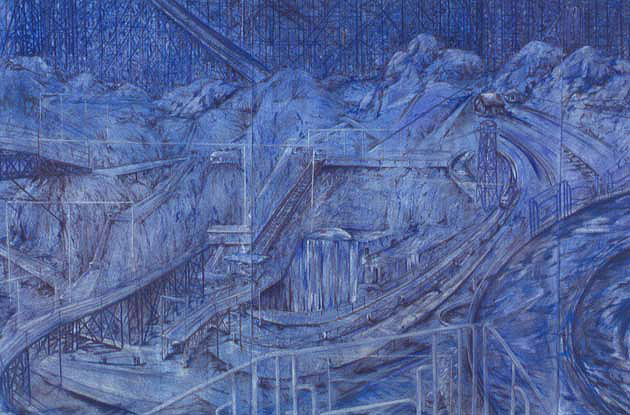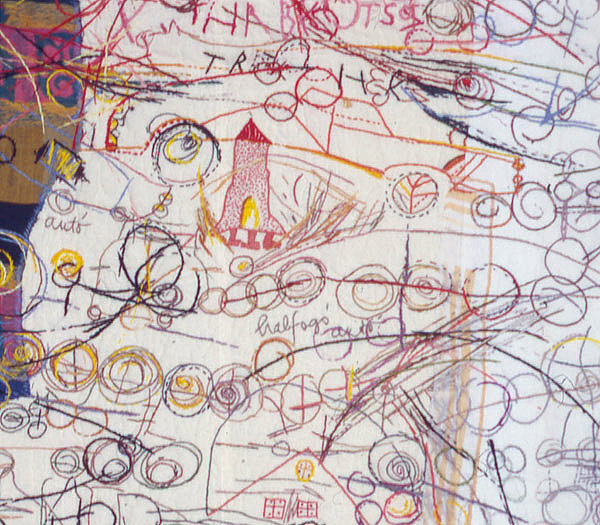
|
Lorna Mills and Sally McKay
Digital Media Tree this blog's archive OVVLvverk Lorna Mills: Artworks / Persona Volare / contact Sally McKay: GIFS / cv and contact |
View current page
...more recent posts

Alison Norlen,Untitled, mixed media on paper, 2004. Collection of the artist, photo: Kim Clarke. Courtesy of MOCCA.
Gary M. Dault's review (scroll down) of the big drawing show—Just My Imagination at MOCCA—is testament to the fact that one person's point of view is not enough when it comes to art, however qualified that person may be. What he describes as spotty, convenient, and massively glum, I would describe as ambitious, surprising, and open-ended. Drawing as a tool is essential to most art practices. In recent years there's been a wealth of smallish self-effacing drawing, a la Royal Art Lodge. This show is full of great big wall-sized drawings that stretch beyond themselves. Established, canonical draw-ers like John Scott sit in visual dialogue with youngsters like Raphaëlle de Groot. Artists who draw, like Michelle Gay, Ed Pien, and Alison Norlen are allowed to shine.
Alison Norlen's panoramic dark blue landscape is the first thing you see upon entering, a spooky, bleak northern setting with sad fantasy roller coaster shimmering in the dim light. Dault complained that the trees in Norlen's background were "poorly rendered," willfully missing the point by reducing this invented, evocative environment to some kind of technical exercise. Ed Pien's light blue wall caught my eye next. An anthropomorphised water spout spins demonically in the centre of the work, while watery figures float and swim in angsty suspension around the vortex. (Ed Pien also has a totally stunning piece on display at York Quay Centre right now, a massive cut-out black paper silhouette of life-sized male figures perched in the laboriously intricate branches of a spreading tree.)

Anna Torma, Draw me a car (detail), hand embroidery on linen with silk threads, 2004. Collection of the artist, photo: Kim Clarke.
Courtesy of MOCCA.
I won't describe everything. Two more highlights for me were Sheila Butler and Anna Torma. Butler is a smart feminist with Nancy Spero-type chutzpa and iconic linear narrative. Spanning the two walls of a corner, penciled lettering tells of a dream in which a sinister man is chasing her. She can't tell if he is trying to pull her down or boost her up, and in the end she realises she is afraid of levitation, scared to go too high, and equally scared of not going high enough. Household items dot the scene, gloves with faces, a kitchen sponge with painted teeth, hands reaching out from every direction. If I had to pick a 'best-in-show,' I must confess that Anna Torma's embroidered wall hangings blew me and Von Bark away, especially the piece titled (I think) "Draw me a Monster." Kids images of fire breathing dinosaurs are rendered in vibrant coloured thread, combined in a jam-packed composition with other items like technical console dials, math sums, landscapes and bits of text describing ancient life on the planet earth from a child's perspective. Like most quilts and weavings, the image reads as an overall density, yet the pattern is based on art composition, a zine-like crammed in chaos that nestles into order and colour when you take a step or two back. Torma is obviously extremely sophisticated, both in her conception and her execution, and Dault's inane dismissal the work—he says the use of kids drawing is "minor-league procedural affectation" says more about him that it does about her. But, as I mentioned, Dault is just one guy, and in this case I think his point of view is off the mark.
An ambitious drawing is a compositional balancing act, all areas of the surface must hold their own, the space must breath and yet retain tension, the marks but be varied and yet cohere. The same criteria apply to an ambitiously curated drawing show. In my opinion Kim Moodie and David Merritt have succeeded in creating an engaged art space full of connections and potential.
NOTE: Entering this show feels great. One reason is MOCCA itself. The gallery is big, with high ceilings and white walls and concrete floors, but unlike, say, Chelsea or Ydessa Hendeles, it is open to the street and the staff are welcoming. Unlike say, the AGO or the Power Plant, MOCCA is both easy to get to and free (suggested donation). North York's loss is Queen Street's gain, and each time I go there I feel like some weird weight has been lifted and I breath a happy sigh. This feeling will pass soon enough, and I'll be full of complaints and expectations, but til then I plan to enjoy the new MOCCA as much as I can.